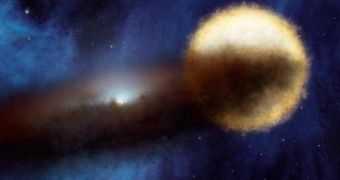The bright star Epsilon Auriga has been an object of fascination for astronomers for nearly 200 years, mostly because of its peculiar, yet-undeciphered nature. The star, which is visible with the naked eye, appears to become brighter, and then dimmer, as the years pass, and early scientists had no idea as to why that happened. Now, astronomers know that, most likely, Auriga is accompanied by another, darker body, which spins around it, reducing its natural brightness from time to time. However, the nature of this binary system remained shrouded in mystery, ScienceDaily reports.
It was only recently that observations from the Spitzer Space Telescope, one of NASA's four Great Observatories, managed to tilt the balance more in favor of one of the two competing theories. With this achievement, experts hope that the long-standing mystery will finally be solved. One of the scenarios that have been proposed over the years holds that Epsilon Auriga is a massive star, which is being periodically darkened by two tightly knit companions, swirling around it in a cloud of dust and gas. The second scenario proposes that the bright star is dying, and that it is only orbited by a single companion. According to the Spitzer measurements, the second idea appears to be closer to reality.
“We've really shifted the balance of the two competing theories. Now we can get busy working out all the details,” Spitzer Science Center expert Donald Hoard explained. The Center is located at the California Institute of Technology (Caltech), in Pasadena. The expert was speaking on January 5 in Washington, at the 215th meeting of the American Astronomical Society (AAS). “It was amazing how everything fell into place so neatly. All the features of this system are interlinked, so if you tinker with one, you have to change another. It's been hard to get everything to fall together perfectly until now,” National Optical Astronomy Observatory (NOAO) scientist Steve Howell added.
Spitzer also determined that the bright star was not an F supergiant, as previously proposed. The first theory held that the body was about 20 times more massive than the Sun, and up to 300 times larger in diameter than our star. But the Spitzer data did not fit this model. Rather, the infrared analysis revealed that the star must be dying, and also that a disk must indeed exist around its companion. The telescope was also able to determine that the disk was about four times the distance between the Earth and the Sun in diameter, or roughly four AU (astronomical units).

 14 DAY TRIAL //
14 DAY TRIAL //